Scallop Dredging (images © Seafish)
Scallop dredges are heavy-duty metal framed nets approximately 85 cm wide, which are pulled over the seabed. A row of metal teeth (10 cm in length) are mounted on the front of the dredge, and these dig into the seabed and flip scallops out of the sand into the nets. Dredges are mounted on metal bars, and a typical Cornish scallop dredging boat will pull a bar from each side of the vessel. Each bar will have up to 6 dredges mounted on it.
A Newhaven scallop dredge with spring-loaded teeth.
There is an obvious physical impact of this type of fishing gear being pulled across the seabed, and this means that the method has been criticised by many environmentalists due to the habitat destruction that occurs. The first time a scalloping vessel hauls its dredges over pristine ground it will have an undeniable impact, but fishermen argue that on soft seabeds that have already been dredged the impact is far less and the effects of tides and waves may exceed the impact of fishing activities in some areas.
Within the Cornwall Inshore Fisheries District 6 mile limit, scallop dredgers are restricted to a maximum of 12 dredges (6 each side) and they cannot dredge at night. The power and size of the vessel is also restricted. The creation of Marine Conservation Zones and Special Areas of Conservation has also significantly restricted the areas in which scallop dredgers can operate. Many Scallop fishermen are now signed up to the Seafish Responsible Fishing Scheme.
Want to find out more? The following scientific papers give more detail on the impact of scallop dredging:
Sewell, J. & Hiscock, K., 2005. Effects of fishing within UK European Marine Sites:guidance for nature conservation agencies. Report to the Countryside Council for Wales,English Nature and Scottish Natural Heritage from the Marine Biological Association.Plymouth: Marine Biological Association. CCW Contract FC 73-03-214A. 195 pp.
www.marlin.ac.uk/PDF/FishGuidance05_Final_Report_screen
CEFAS Red Bag Scheme Scallop Survey final report. July 2014
Diesing, M., Stephens, D., and Aldridge, J. 2013 A proposed method for assessing the extent of the seabed significantly affected by demersal fishing in the Greater North Sea. – ICES Journal of Marine Science, DOI:10.1093/icesjms/fst066.

.jpg)


